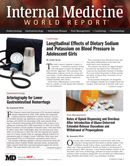Publication
Article
Internal Medicine World Report
Inadequate Data on Sexual Function for Baldness Treatment
Author(s):
Sexual function data is not adequately reported in finasteride clinical trials, a treatment for male pattern baldness, according to an investigation published in JAMA Dermatology.

Inadequate or inaccurate data has been reported regarding the sexual safety of finasteride for hair loss treatment in men, according to an investigation published in JAMA Dermatology.
Researchers from Northwestern University Feinberg School of Medicine reviewed 34 clinical trials in order to assess safety reporting for clinical trial reports of finasteride for androgenic alopecia (AGA). The researchers examined the quality of adverse event reporting for each trial. In addition, they extracted the number and type of adverse events in treatment and placebo groups and assessed the duration of safety evaluation and adequacy of blinding.
There were two independent observers of the extraction of the data, the researchers added. The men who participated in the finasteride AGA clinical trials were prescribed finasteride 1.25 mg/ daily or less. The researchers then categorized the clinical studies into groups: adequate quality, partially adequate, inadequate, or no events reported.
Of 34 clinical trials included in the analysis, 19 were partially adequate, 12 were inadequate, and three studies reported no adverse events. Furthermore, not one study published adequate information about the severity, frequency, or reversibility of sexual adverse effects, according to the investigators. There were three key questions that the researchers believe patients want answers to, but those answers were not provided:
1. How safe is finateride? What kinds of risks does a man face sexually when taking finasteride?
2. How severe is sexual dysfunction related to finasteride treatment?
3. Will sexual function return when finasteride treatment is stopped if dysfunction does develop? Similarly, what is the risk of sexual dysfunction related to finasteride being permanent?
“People who take or prescribe the drug assume it’s safe, but there is insufficient information to make that judgment,” lead study author Steven Belknap explained in a press release. “Our findings raise several questions. Why do the published reports of these 34 clinical trials not provide adequate information about the severity and frequency of sexual toxicity? Was this information obtained but then not included in published articles? Or, were these clinical trials performed in a way that simply didn’t capture this essential information? And most importantly, is the risk to benefit ratio of finasteride acceptable?”
According to the researchers, the drug safety duration in a quarter of the clinical trials was limited to a year or less. But a third of the 5,704 men included across the 34 clinical trials evaluated had taken finasteride for more than 1 year.
“Available toxicity information from clinical trials of finasteride in men with AGA is very limited, is of poor quality, and seems to be systematically biased,” the authors concluded. “Published reports of clinical trials provide insufficient information to establish the safety profile for finasteride in the treatment of AGA.”






